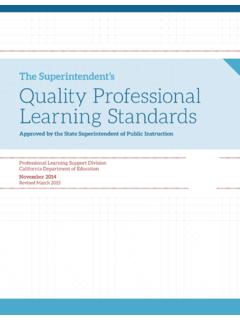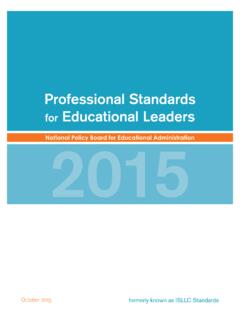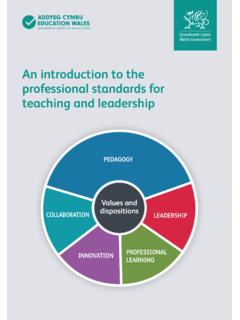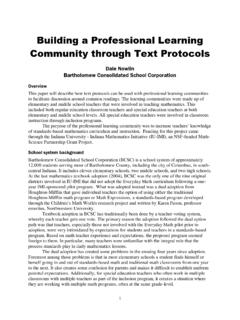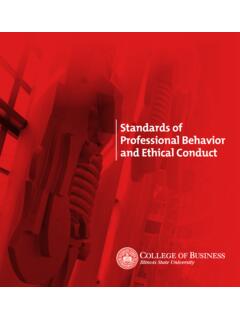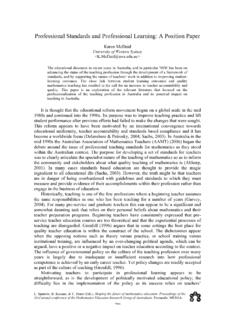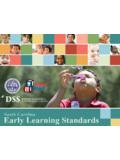Transcription of V S for the P of teacherS - Virginia Department of Education
1 Virginia standards for the professional Practice of teacherSApproved by the Virginia Board of Education May 21, 2008 Coordinated by the Division of teacher Education and LicensureVirginia Department of Box 2120 Richmond, Virginia 23218-2120 TABLE OF CONTENTSI ntroduct on ..1 standards for the Profess onal Pract ce of All teacherS ..3 standards for the Profess onal Pract ce of teacherS n Spec fic D sc pl nes and Spec al zed Areas teacherS of English ..5 teacherS of History and Social Science ..8 teacherS of Mathematics ..12 teacherS of Science ..15 teacherS of Career and Technical Education ..18 teacherS of English as a Second Language ..22 teacherS of Fine Arts ..25 teacherS of Foreign Language ..28 teacherS of Health, Physical, and Driver Education ..31 teacherS of Special Education ..35 Append ces Appendix A: Supplemental Document A - Inquiry Format ..41 Appendix B: Supplemental Document B - Exemplar Format ..50 Acknowledgements ..601 Virginia standards for the professional Practice of TeachersIntroductionThe Virginia standards for the professional Practice of teacherS have been developed as a result of a recommendation from the Committee to Enhance the K-12 Teaching Profession in Virginia established by the Virginia Board of Education and the State Council of Higher Education for Virginia .
2 These standards are intended as a resource for school divisions in the implementation of the Board of Education s performance standards and evaluation criteria for standards are designed to provide a conceptual model of good teaching. They represent the knowledge and skills that are common to all teacherS from pre-kindergarten through grade 12. teacherS need to know what will be expected of them and how they will be evaluated. The standards will assist teacherS to reflect on student learning , teaching, and to develop professional development plans to improve teaching standards are not intended to describe the performance of beginning teacherS , but rather, they are intended to guide the development of all teacherS throughout their careers as they continually seek to improve their Virginia standards for the professional Practice of teacherS are presented in two sections: standards for the professional Practice of All teacherS and standards for the professional Practice of teacherS in Specific Disciplines and Specialized Areas.
3 The standards for the professional Practice of teacherS in Specific Disciplines and Specialized Areas include standards for teacherS of English; history and social science; mathematics; science; career and technical Education ; English as a Second Language; fine arts; foreign language; health, physical, and driver Education ; and special Education . The standards are organized around six interrelated categories of teaching practice. The six categories of standards or teaching practices are: Knowledge of Students Knowledge of Content Planning, Delivery, and Assessment of Instruction Safe, Effective learning Environment Communication and Collaboration Professionalism Within each standard are key elements that describe the knowledge that teacherS possess and actions that they take to advance student learning . Together these six standards and key elements represent the scope and complexity of standards for the professional Practice of teacherS in Specific Disciplines and Specialized Areas follow the same format as the Virginia standards for the professional Practice of All teacherS and build on the Virginia Licensure Regulations for School Personnel and the Virginia standards of learning .
4 standards developed by the National Board for professional Teaching standards in the various content areas also guided the work of the content-specific task force further guide teacherS as they define and develop their practice around the six standards , the task force created two supplemental documents. Supplemental Document A uses an inquiry approach to foster ongoing reflection and insights into teaching through questions that encourage teacherS to examine key aspects of teaching within each standard. Supplemental Document B provides examples of the knowledge, skills, actions, and attitudes exhibited by teacherS who are meeting each standard. These questions address only a sample of important aspects of teaching and are not intended to be used as a checklist. Rather, they are intended to guide the development of all teacherS throughout their careers as they continually seek to improve their for the professional Practice of All TeachersStandard One: Knowledge of StudentsThe teacher understands how students learn and develop and provides learning opportunities that support their intellectual, social, and personal Two: Knowledge of ContentThe teacher understands the central concepts, structures, and processes of the discipline(s) he/she teaches and creates learning experiences that make these aspects of subject matter meaningful to Three: Planning, Delivery, and Assessment of InstructionThe teacher plans, delivers, and assesses instruction Element 1: The teacher designs coherent instruction based upon knowledge of subject matter, students, the community, and curriculum Element 2: The teacher plans instruction to achieve objectives that reflect the Virginia standards of learning and division curriculum Element 3.
5 The teacher differentiates instruction to accommodate the learning needs of all Element 4: The teacher uses materials, technology, and resources that promote the development of critical thinking, problem solving, and performance Element 5: The teacher selects, evaluates, and adapts multiple methods and instructional strategies to engage students and enhance student Element 6: The teacher uses appropriate verbal, nonverbal, and media communication techniques to foster positive interactions in the Element 7: The teacher communicates specific performance expectations and uses a variety of assessment strategies to plan instruction and to monitor and document student progress. Standard Four: Safe, Effective learning EnvironmentThe teacher establishes and maintains a safe and disciplined environment conducive to Element 1: The teacher creates a safe and positive environment for Element 2: The teacher manages classroom procedures to maximize academic learning time to ensure continuous student engagement in Element 3: The teacher develops and maintains rapport with Element 4: The teacher creates a supportive learning environment for all students that encourages social interaction, active engagement in learning , and Five: Communication and CollaborationThe teacher establishes partnerships and collaborates with families, administrators, colleagues, and community members to promote and support student Element 1: The teacher works in partnership with families to promote student learning at home and in the Element 2.
6 The teacher collaborates with administrators, colleagues, families, and community members to promote and support student Six: ProfessionalismThe teacher models Element 1: The teacher models professional and ethical standards as well as personal integrity in all Element 2: The teacher continually reflects on, evaluates, and seeks to improve his/her Element 3: The teacher takes responsibility for and participates in a meaningful and continuous process of professional development. standards for the professional Practice of teacherS in Specific Disciplines and Specialized Areas: teacherS of EnglishStandard One: Knowledge of StudentsTeachers of English use information regarding students prior knowledge and development to guide instruction and to develop and enhance English Two: Knowledge of ContentTeachers of English demonstrate an understanding of the knowledge, skills, and processes of Element 1: teacherS of English use standards , resources, and techniques to maximize student learning in the areas of speaking, listening, reading, writing, and Element 2: teacherS of English use a variety of texts, ideas, perspectives and approaches in the study of literature to expand students knowledge of themselves and their Element 3: teacherS of English apply the conventions of standard English in reading, writing, and oral Element 4.
7 teacherS of English understand the writing process and use a variety of modalities to help students apply knowledge of grammar, usage, and mechanics to the Element 5: teacherS of English are knowledgeable of a variety of effective reading strategies and help students develop, recognize, and expand the use of these strategies, as well as adjust them to suit the purpose, task, and text. Standard Three: Planning, Delivery, and Assessment of InstructionTeachers of English demonstrate knowledge in the planning, delivery, and assessment of English Element 1: teacherS of English select and create materials based on instructional purpose, literary merit, impact of the medium, parameters of the curriculum and students developmental Element 2: teacherS of English use a variety of teaching strategies and differentiated instruction to guide students in developing literacy, critical thinking, problem-solving, and writing Element 3: teacherS of English encourage students self-directed learning and the creative application of oral language, writing, and reading Element 4: teacherS of English encourage inquiry and require students to provide credible evidence from a variety of Element 5.
8 teacherS of English incorporate real world texts, technology, and written and oral responses to enhance students understanding of the importance of language skills beyond the Element 6: teacherS of English facilitate students active learning through projects, collaborative work, multi-media, and oral Element 7: teacherS of English engage students in a variety of formative and summative assessments to include oral, written, and Four: Safe, Effective learning EnvironmentTeachers of English create and maintain a classroom environment that supports and encourages students to develop and practice communication skills. They create an intellectual environment that enables students to develop competence in reading, writing, listening, and speaking skills. They encourage opportunities for students to select texts or issues of personal interest and promote appropriate communication of each student s viewpoints. Standard Five: Communication and CollaborationTeachers of English collaborate with peers and other educational professionals to extend student learning experiences by inviting poets, authors, storytellers, and other literary professionals into the classroom.
9 These learning experiences may include student writing as well as providing opportunities for speeches, presentations, and dramatic Six: ProfessionalismTeachers of English reflect on what they teach and how they teach. They keep abreast of current research-based practices in English and continually seek to improve their knowledge and practice. standards for the professional Practice of teacherS in Specific Disciplines and Specialized Areas: teacherS of History and Social Science Standard One: Knowledge of StudentsTeachers of history and social science use information regarding student development, prior knowledge, background, interests, and experiences with history and social science to design thoughtful curricula and to provide effective instruction. Standard Two: Knowledge of ContentTeachers of history and social science demonstrate an understanding of the knowledge, skills, processes, and democratic values of history and social Element 1: teacherS of history/social science understand the concepts, big ideas, essential questions, and essential knowledge from the disciplines of history, geography, economics, and civics included in the Virginia standards of learning for History and Social Element 2: teacherS of history/social science integrate knowledge from history, geography, economics, and civics in their courses, and from other academic disciplines as Element 3: teacherS of history/social science use content from history, geography, economics, and civics to develop the skills of (1) acquiring, organizing, and interpreting information from primary and secondary sources; (2) historical inquiry; (3) reading and interpreting maps, graphs, charts, and political cartoons.
10 (4) making and defending decisions on public policies; and (5) actively participating in groups. Key Element 4: teacherS of history/social science understand and appreciate the core values of life, liberty, truth, equality of opportunity, and justice that form the foundation of American democracy and how conflicts exist among these Element 5: teacherS of history/social science understand and appreciate the cultural diversity of American society and of the world and how experiences may be interpreted differently by people from diverse cultural perspectives and frames of reference. Key Element 6: teacherS of history/social science are knowledgeable of significant historical periods, the role of conflict and cooperation, and patterns of continuity and change in United States and World Element 7: teacherS of history/social science are knowledgeable of places and regions of the world, the physical processes that shape the earth, patterns of movement and interconnectedness, and the forces of cooperation and conflict among peoples around the Element 8: teacherS of history/social science are knowledgeable of the purpose and organization of government and know how to promote the active participation of citizens in a Element 9: teacherS of history/social science understand how the market economy and other types of global economies organize for the production, distribution and consumption of goods and Three.











